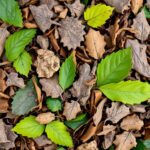Are Banana Peels Good for Compost? Discover Their Benefits and Tips for Use

Banana peels are often overlooked as a valuable addition to compost bins, yet they hold numerous benefits for garden enthusiasts. Rich in essential nutrients like potassium, phosphorus, and calcium, banana peels can enhance soil quality and promote healthy plant growth. In this article, we will explore the advantages of incorporating banana peels into your compost mix, as well as practical tips for their effective use. Whether you're new to composting or looking to optimize your garden’s output, understanding the role of banana peels can transform your approach to sustainable gardening and waste management.
Are Banana Peels Beneficial for Compost?
Yes, banana peels are not only edible but highly beneficial for composting. They are rich in essential nutrients such as potassium, phosphorus, and calcium, which contribute to soil health and ultimately enhance plant growth. When added to a compost pile, banana peels break down relatively quickly due to their soft texture, enriching the compost with organic matter. The microorganisms in the compost will easily decompose the peels, transforming them into nutrient-rich compost that can improve the fertility of your garden soil. Moreover, their natural sugars attract beneficial organisms that aid in the decomposition process, making them an excellent addition to any composting system.
Nutritional Value of Banana Peels
Banana peels are not just scraps; they offer impressive nutritional value for your compost. They contain high levels of potassium and phosphorus, minerals vital for plant growth and flowering. These nutrients help in the development of roots and improving overall plant vigor. Their composition ensures that when they decompose, they release these essential nutrients slowly into the soil, providing a sustained source of nourishment for plants over time.
How to Prepare Banana Peels for Composting
Before adding banana peels to your compost, consider chopping them into smaller pieces. This action helps to speed up the decomposition process significantly, as smaller pieces have a larger surface area exposed to microorganisms. You can place them directly into your compost bin or pile after cutting them up, ensuring they mix well with other compost materials. This preparation contributes to a more efficient breakdown and enhances the overall quality of your compost.
Potential Pests and Issues
While banana peels are great for composting, they can also attract certain pests if not managed properly. The sugars present in banana peels may attract fruit flies and other insects. To mitigate this, ensure that the banana peels are buried in the compost pile and are well-mixed with other materials. This will help reduce the likelihood of pest issues while still allowing you to take advantage of their beneficial properties.
See also:
Composting Methods for Banana Peels
Banana peels can be included in different composting methods, such as traditional piles or vermicomposting. Traditional composting allows for aerobic decomposition where peels break down over several weeks to months, depending on conditions. In contrast, vermicomposting utilizes red worms to rapidly decompose banana peels, resulting in nutrient-dense worm castings much sooner. Both methods highlight the versatility and effectiveness of incorporating banana peels into your composting strategy.
Effects on Soil Quality
When banana peels decompose, they greatly enhance the soil quality of your garden. The nutrients released from the peels improve soil structure and fertility, encouraging strong root systems and promoting healthy plant growth. Additionally, using banana peels in compost can help retain moisture in the soil, which is especially beneficial during dry periods. Overall, the incorporation of banana peels leads to a more vibrant and productive gardening environment.
| Nutrient | Function |
|---|---|
| Potassium | Essential for water regulation and flowering |
| Phosphorus | Promotes root growth and energy transfer |
| Calcium | Helps maintain strong cell walls |
Understanding the Nutritional Value of Banana Peels for Compost
Banana peels are often discarded, but they possess significant nutritional value for composting. Rich in potassium, phosphorus, and essential trace minerals, these peels can enhance the overall quality of compost. When added to compost, they break down relatively quickly, contributing to the microbial diversity and accelerating the composting process. Additionally, the organic matter in banana peels helps to maintain moisture levels in the compost while promoting healthy plant growth when used in the garden. Their ability to attract beneficial organisms makes them a valuable addition to any compost pile.
Benefits of Using Banana Peels in Compost
Incorporating banana peels into compost provides numerous benefits. They not only enrich the compost with nutrients but also improve soil structure. The high levels of potassium in banana peels can promote strong root development and flowering in plants. Moreover, the peels help to lower the acidity of the compost, making it more balanced for plant use. Overall, using banana peels can lead to healthier plants, improved soil fertility, and a more effective composting process.
How to Properly Prepare Banana Peels for Composting
To maximize the benefits of banana peels in your compost, it's essential to prepare them correctly. First, cut the peels into smaller pieces to facilitate faster decomposition. This increases the surface area and allows microorganisms to break down the material more easily. Additionally, it's advisable to rinse off any pesticides or additives from the peels before composting. Combining banana peels with a mix of browns (like dried leaves or cardboard) and greens (like vegetable scraps) ensures a balanced compost that breaks down efficiently.
See also:
Potential Drawbacks of Composting Banana Peels
While banana peels are a great addition to compost, there are some potential drawbacks to consider. If used in excess, banana peels can contribute to an overly wet compost, leading to anaerobic conditions and unpleasant odors. They also can attract unwanted pests if not balanced with enough carbon-rich materials. Moderation is key; using banana peels in combination with a variety of other compost materials will help maintain a healthy compost pile.
Creating a Balanced Compost with Banana Peels
To create a balanced compost that includes banana peels, it's important to maintain the right carbon-to-nitrogen ratio. Banana peels are considered a "green" material, which means they are rich in nitrogen. Pairing them with "brown" materials, such as shredded paper or straw, helps balance the nutrient levels. The ideal ratio is approximately 2:1 of browns to greens. This balance ensures effective aeration, moisture retention, and a thriving microbial community, resulting in rich, dark compost.
Using Banana Peel Compost in Your Garden
Compost made with banana peels can be incredibly beneficial when used in your garden. The nutrients released during decomposition provide essential elements for plant growth. When mixed into the soil, this compost not only nourishes plants but also enhances soil texture, improving its ability to retain moisture and drain properly. Furthermore, applying banana peel compost around flowering plants can help increase blooms and fruit yields due to its high potassium content. Overall, using this compost in your garden fosters a thriving ecosystem that promotes healthy plants.
Questions from Our Readers
Are banana peels good for compost?
Yes, banana peels are excellent for composting as they are rich in essential nutrients such as potassium, phosphorus, and calcium, which are beneficial for plant growth. Including banana peels in your compost promotes better soil health and enhances the nutrient content of your compost.
How should I prepare banana peels for composting?
To prepare banana peels for composting, simply chop them into smaller pieces to accelerate the breakdown process. This helps increase the surface area, allowing microorganisms to decompose the peels more efficiently and enrich your compost pile.
See also:
Can I add banana peels to a vermicompost bin?
Absolutely! Banana peels are a great addition to a vermicompost bin, as they provide essential nutrients for worms. Just ensure to chop them into small pieces to avoid attracting pests and to make it easier for worms to process them.
Are there any downsides to composting banana peels?
While banana peels are beneficial, they can attract pests if not properly managed in compost. To mitigate this, ensure that you balance them with carbon-rich materials such as dry leaves or cardboard, and maintain moisture levels to keep the compost heap healthy and balanced.

If you want to read more articles like Are Banana Peels Good for Compost? Discover Their Benefits and Tips for Use, we recommend you check out our Compost category.
Leave a Reply
Related Articles